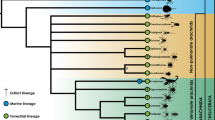Abstract
Phylogenetic analysis of α chains of voltage-gated ion channels revealed that extensive gene duplication has occurred among both Ca2+ and Na+-channels since the origin of vertebrates. Rather than showing a pattern of gene duplication consistent with the hypothesis of polyploidization early in vertebrate history, both Ca2+ and Na+ channels showed patterns of sequential gene duplication associated with specialization of the gene products. In the case of Na+ channels, the phylogeny supported the hypothesis that the ancestral vertebrate gene had an expression pattern including both central and peripheral nervous system cells and that duplication of vertebrate Na+ channel genes has repeatedly been followed by specialization for the central nervous system, the peripheral nervous system, or muscle cells. Thus, cephalization in vertebrate evolution has been accompanied by specialization of this important family of neuromuscular proteins along the central–peripheral axis.
Similar content being viewed by others
Author information
Authors and Affiliations
Rights and permissions
About this article
Cite this article
Piontkivska, H., Hughes, A. Evolution of Vertebrate Voltage-Gated Ion Channel α Chains by Sequential Gene Duplication . J Mol Evol 56, 277–285 (2003). https://doi.org/10.1007/s00239-002-2399-9
Received:
Accepted:
Issue Date:
DOI: https://doi.org/10.1007/s00239-002-2399-9




